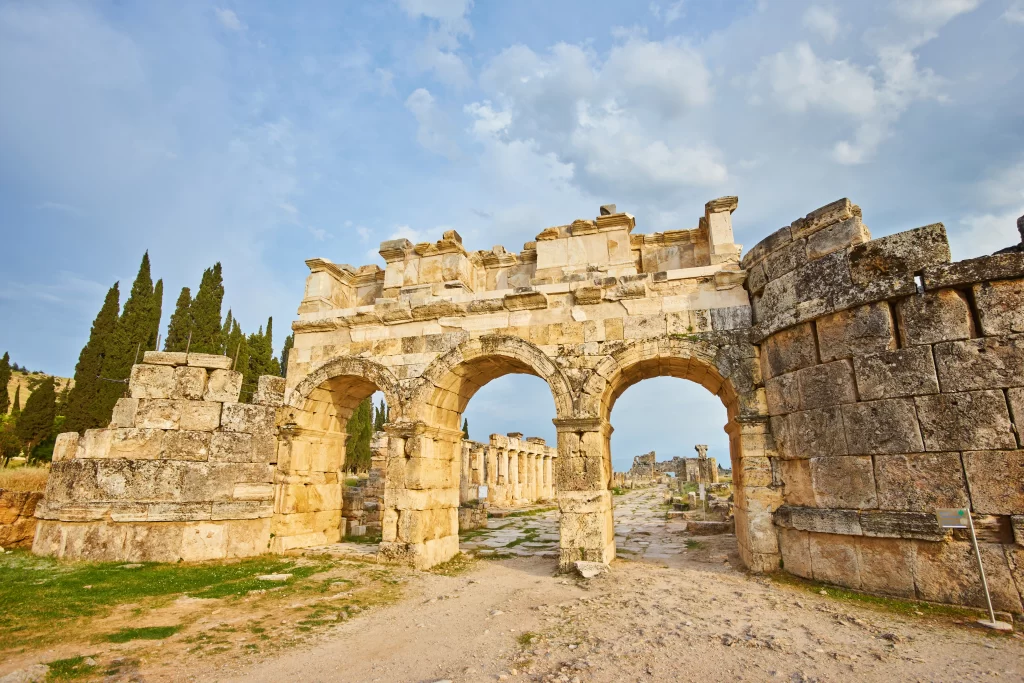Pamukkale, often referred to as the “Cotton Castle,” is a natural wonder that has graced the landscapes of Turkey for centuries. Situated near the ancient city of Hierapolis, this geological marvel holds a secret history that goes beyond its stunning terraces and thermal pools. Join us as we uncover the lesser-known details and hidden tales of Pamukkale and Hierapolis, weaving a narrative that transcends time.
Pamukkale: Nature’s Artistry Carved in Stone
The first keyword in our exploration is Pamukkale, a name that conjures images of cascading terraces resembling a frozen waterfall. But the secret lies in the geological processes that shaped this natural wonder.
Geological Marvel: Pamukkale’s terraces are formed by the rich mineral content of the thermal waters that flow down the mountainside. The calcium carbonate deposits create the unique stepped formations that make Pamukkale a UNESCO World Heritage Site.
Ancient Healing Waters: While the terraces are a sight to behold, the thermal waters of Pamukkale have drawn visitors for their reputed healing properties since antiquity. The warm, mineral-rich waters were believed to cure various ailments, leading to the establishment of a healing center in the nearby city of Hierapolis.
Eternal Charm: Pamukkale’s allure extends beyond its geological uniqueness. As the sun sets, the terraces take on hues of pink and orange, creating a magical atmosphere that has captivated travelers for centuries.

Hierapolis: Ancient Splendor Unearthed
Our second keyword, Hierapolis, is inseparable from the history of Pamukkale. This ancient city, perched above the terraces, adds layers of historical significance to the region.
Theater of Grandeur: Hierapolis boasts an exceptionally well-preserved Roman theater that once accommodated thousands of spectators. The acoustics of this ancient amphitheater are a testament to the architectural prowess of its builders.
Sacred Necropolis: The Necropolis of Hierapolis is not merely a burial ground but a testament to the city’s multicultural population. With tombstones adorned with various symbols and inscriptions, it reflects the diverse beliefs and customs of the people who called Hierapolis home.
Gate to the Underworld: The Plutonium, a mysterious cave in Hierapolis, was believed by the ancients to be the entrance to the underworld. Pilgrims and priests conducted rituals here, harnessing the power of the noxious gases emitting from the cave.
Ancient Thermal Baths: Hierapolis was renowned for its thermal baths, strategically utilizing the healing properties of Pamukkale’s thermal waters. The elaborate infrastructure of the baths highlights the importance placed on health and well-being in ancient times.
Turkey: A Tapestry of Ancient Wonders
Turkey, serves as the backdrop for the intertwined histories of Pamukkale and Hierapolis. Turkey, a country that spans two continents, holds within its borders a tapestry of ancient wonders waiting to be explored.
Crossroads of Civilizations: Turkey’s geographical position has made it a crossroads of civilizations throughout history. Pamukkale and Hierapolis stand as testament to the diverse cultures that have left their mark on this land.
Cultural Heritage: Turkey’s rich cultural heritage is evident in the archaeological sites scattered across the country. Pamukkale and Hierapolis are integral parts of this cultural mosaic, offering insights into the daily lives, beliefs, and architectural achievements of ancient civilizations.
Tourist Haven: In the modern era, Turkey has become a tourist haven, welcoming travelers from around the world to explore its historical sites, vibrant cities, and diverse landscapes. Pamukkale, with its allure and historical significance, is a must-visit destination on any traveler’s itinerary.
Pamukkale Tour: Journey Through Time and Nature
A well-designed Pamukkale tour, encapsulates the essence of experiencing this enchanting destination. A journey through time and nature awaits those who embark on a Pamukkale tour.
Guided Exploration: Many tourists opt for guided tours to fully grasp the historical and geological significance of Pamukkale and Hierapolis. Knowledgeable guides provide insights into the secret histories and lesser-known details that add depth to the experience.
Balloon Rides: For a unique perspective, some tours offer hot air balloon rides over Pamukkale, providing a bird’s-eye view of the terraces, the ancient city, and the surrounding landscapes.
Thermal Baths Experience: While modern travelers may not partake in ancient healing rituals, they can indulge in the modern spa facilities that utilize Pamukkale’s thermal waters, offering a relaxing and rejuvenating experience.
Sunset Magic: A Pamukkale tour often culminates in witnessing the sunset over the terraces. As the sun bathes the landscape in warm hues, the mystical atmosphere transports visitors to a different era.
In unraveling the secret history of Pamukkale and Hierapolis, we discover a narrative that spans millennia. From the geological wonders of Pamukkale to the ancient splendor of Hierapolis, and the broader context of Turkey’s rich cultural tapestry, the journey through time and nature is both enlightening and enchanting. A Pamukkale tour becomes a pilgrimage through history, where the echoes of ancient civilizations and the whispers of nature tell a story that is, at once, timeless and ever-evolving.



Comment (0)